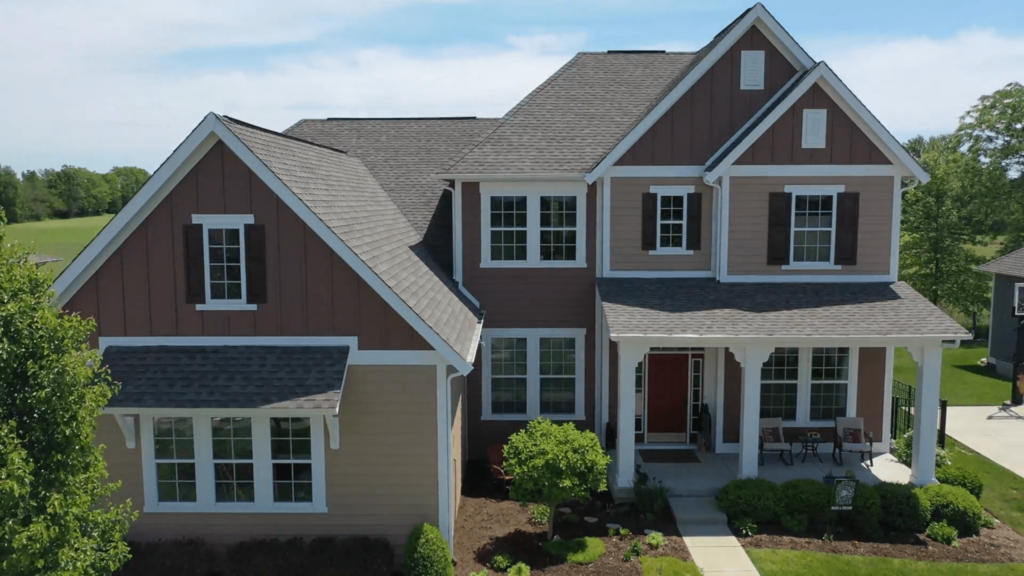A fresh coat of exterior house paint is among the most impactful and effective ways to increase your home’s curb appeal. Whether for your enjoyment or if you’re investing in improvements to attract potential buyers, a new coat of exterior paint can make a dramatic difference in your home’s appearance. But how long does exterior paint last? While there’s no universal answer, this post will cover the variables and what you might expect.
What factors affect how long exterior paint lasts?
Exterior Materials. The materials used to make up a home’s exterior will be the largest and most influential factor in how often it will require repainting. Due to porosity, shrinking, and swelling, brick and stucco, wood siding, aluminum siding, and vinyl siding have different lifespans.
- How long does exterior paint last on wood? As wood ages, painted surfaces will naturally deteriorate and lead to paint fading or cracking. Softwoods, particularly cedar and pine, are more vulnerable to rot and damage and may require repainting every three to five years. Hardwoods, including oak or pine, are more durable, and some of the longest-lasting exterior paint for wood will last up to 10 years.
- How long does exterior paint last on brick? There are pros and cons of painting exterior brick. It’s become an in-style solution for modernizing a home’s appearance and adds a layer of protection. Painting a brick exterior is also nearly irreversible as brick’s porosity will require significant paint removal and chemical wash work to undo. While it will require more-frequent upkeep, exterior paint on brick or similar stone and stucco materials will last 10 to 20 years.
- How long does exterior paint last on vinyl or aluminum siding?Vinyl and aluminum siding are other materials homeowners can see exterior paint that lasts 20 years. Considered lower-maintenance home exterior materials, repainting vinyl or aluminum siding is a much more economically viable solution than replacement costs. They’re durable materials that don’t swell or shrink like wood. Signs of fading or oxidation may appear sooner and call for occasional touch-ups or maintenance. Still, exterior paint on vinyl or aluminum should last between at least ten years and up to 25 or longer.
Temperature and Climate. Aside from your home’s specific exterior materials, the weather and climate in your area are the next-most important factors in how long your home’s exterior paint film will last. The best exterior paint for hot climates (usually acrylic latex paint) differs from what may be best in areas of heavy rain and storms (oil-based paint), for example. Ideal temperatures for exterior house painting are generally between 50 to 80 degrees Fahrenheit. However, some specialty paints expand the flexibility of that range and can be applied in temperatures as low as 35 degrees Fahrenheit.
Sunlight. The sun’s ultraviolet rays will cause any paint to fade over time, but darker tones will experience bleaching or color changing faster than lighter shades. Keep an eye out for any noticeable fading on primarily shaded portions of your house, as it could be a sign of underlying water damage.
Application Preparation. For exterior paint to adhere and look its best for years, proper preparation is key even before a first primer coat is applied. Power washing is an effective means to clean and prepare the house exterior before painting, as is scraping away any loose old paint or making any repairs to ensure a smooth, even surface. Note that home and commercial-grade power washers are different, so hiring a professional with proper equipment will likely give you the best outcome.
Maintenance. Regular maintenance will play an important role in extending the lifespan of your home’s exterior paint and help it last longer between major repainting projects. Follow these tips for best results:
- An annual, or more frequent, thorough washing will eliminate all sorts of surface contaminants such as dirt, bird droppings, pollen, mildew, mold spores, and other air pollutants that can cause paint to deteriorate prematurely.
- If certain surfaces or portions of your home experience deterioration before others, touch-up painting or sealing to those areas every couple of years can add significant life to the paint job.
- Your home’s surrounding landscaping could also negatively affect your exterior paint. Nearby trees, bushes, and shrubs can block airflow and sunlight from the house perimeter. That will keep exterior walls wetter longer from rain or sprinklers and promote mildew or mold growth, wood rot, and further deterioration.
- Damaged, clogged, or otherwise malfunctioning gutters and downspouts are another potential source of premature wear and tear to your home’s exterior paint. A neglected gutter backing up and overflowing should be repaired as soon as possible to keep excessive moisture from gathering on exterior paint and the surfaces underneath.
Trust the Experts at ONiT Painting
Is your home exterior ready for a refresh? If you’re searching for a new splash of color, or your exterior house paint shows signs of cracking, peeling, or fading, reach out to ONiT Painting today for a free estimate. Our experts understand the importance of proper paint selection, surface preparation, and best application practices to ensure your home’s new exterior paint lives a long, vibrant, and beautiful life.





